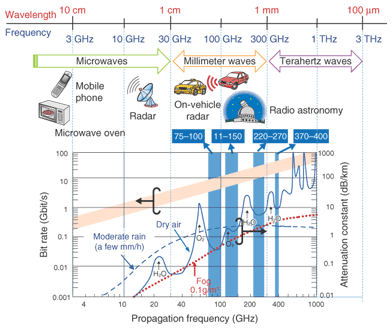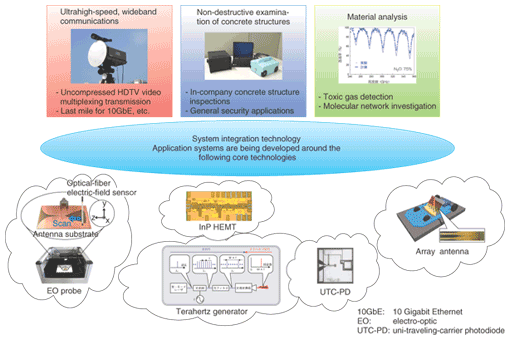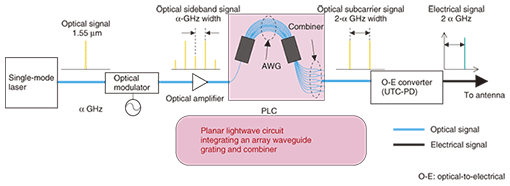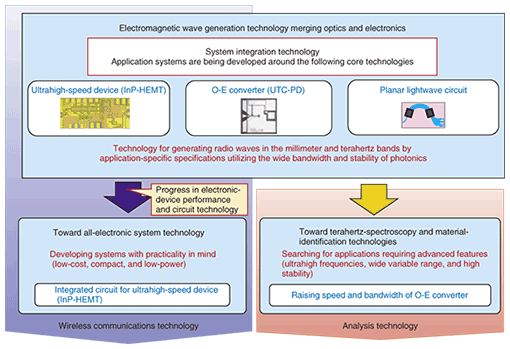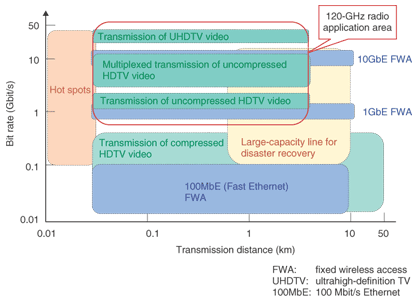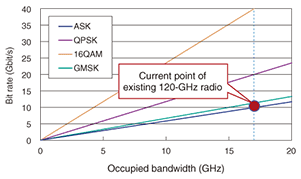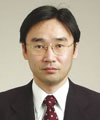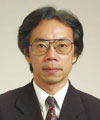 |
|||||||||||||||||||||||||
|
|
|||||||||||||||||||||||||
|
Special Feature: Applied Technology for Millimeter and Terahertz Electromagnetic Waves Vol. 7, No. 3, pp. 5–10, Mar. 2009. https://doi.org/10.53829/ntr200903sf1 Overview of Millimeter and Terahertz Wave Application ResearchAbstractMillimeter and terahertz wave technologies are fields that lie at the borderline between electronics and photonics. Both are expected to find widespread use in communications, measurements, medical care, biochemistry, and other fields. This article introduces research on the application of millimeter and terahertz waves at NTT Microsystem Integration Laboratories.
1. IntroductionMillimeter and terahertz waves are both electromagnetic waves just like microwaves, radio waves, and visible and infrared light. Millimeter waves lie in the frequency region from 30–300 GHz (wavelength: 1–10 mm) and receive their name because their wavelengths are of the millimeter order. Terahertz waves lie in the region from 300 GHz to 3 THz (wavelength: 100 µm to 1 mm) and receive their name because their frequencies are of the terahertz order, where tera (T) is a prefix denoting 1012. The terahertz waves making up this frequency band are sometimes called submillimeter waves. Although some definitions of terahertz waves include the far-infrared region (up to 10 THz), here we consider their range to extend up to only 3 THz, which is the upper limit of radio waves as defined in Japan’s Radio Law. So what kinds of features do millimeter and terahertz waves possess? As shown in Fig. 1, electromagnetic waves up to and including microwaves that have relatively low frequencies are generally unaffected by rain and other atmospheric effects. This has made them suitable for long-range radio communications such as television (TV) and radio broadcasting. In comparison, millimeter and terahertz waves suffer from attenuation caused by rain and resonant absorption in oxygen and water molecules, so they are unsuitable for long-range radio communications. However, their short wavelengths prove to be an advantage in the transmission of large amounts of data at one time. Millimeter and terahertz waves also provide high spatial resolution in imaging applications, enabling high-definition images to be obtained, in contrast to the low definition of microwave imaging.
Moreover, in the terahertz region, it may be possible to detect molecular networks through weak inter-molecule coupling, which could lead to the application of terahertz waves to protein analysis and drug discovery. This is explained in more detail in the article entitled “Terahertz Spectroscopy Technology for Molecular Networks” in this Special Feature. On the other hand, as the wavelengths of electromagnetic waves become shorter, it becomes more difficult for those waves to penetrate matter. This property makes it difficult to use them to analyze the deep interior of matter. Moreover, looking at the millimeter- and terahertz-wave regions in Fig. 1, we can see that they include several sub-regions (windows) having relatively little attenuation compared with neighboring frequencies. Considering that radio-frequency resources are limited, research and development efforts must keep in mind that the way in which these windows are applied could have great importance for industry and the advancement of the human race. We have been performing fundamental research and development of technology for millimeter and terahertz waves exploiting the above mentioned features with the aim of meeting diverse needs both inside and outside NTT (Fig. 2).
2. Current state of developmentIn the millimeter region, the 76-GHz band is being mainly used for crash-prevention radar in automobiles. The 60-GHz band, meanwhile, is being targeted for short-range wireless communications with various usage formats now under study at IEEE 802.15.TG3c (Working Group for Wireless Personal Area Networks, Task Group 3c). These include an application for transmitting uncompressed high-definition (HD) video from a DVD (digital versatile disc) player or other device to a flat-screen TV and an application for downloading HD video to a mobile terminal from a video kiosk and transferring that content from the terminal to a set-top box or personal computer in the home [1]. In January 2008, the WirelessHD™ Consortium, an industry organization, announced version 1 of specifications for the next-generation wireless digital interface [2]. Discussions on putting the 60-GHz band to good use have been highly active because it offers a relatively large bandwidth of 7 GHz that can be used license-free, and recent progress in silicon-device technology has opened up practical use of this frequency band through SiGe and CMOS (complementary metal oxide semiconductor) processes. At the same time, wireless equipment for transmitting Gigabit Ethernet signals in a point-to-point fashion using the 70/80-GHz bands is now being commercialized in the USA and Europe for inter-building communications [3]. At present, though, bit rates are capped at 2 Gbit/s. In IEEE.802.15, the Terahertz Interest Group was established in March 2008 and discussions have begun on wireless communications using the terahertz band above 300 GHz [4]. Attention is also being focused on applications using even higher frequencies at several terahertz. One example is non-destructive analysis of drugs and other substances using terahertz time-domain spectroscopy using pulse waves produced by an ultrahigh-speed femtosecond laser. Such an application could be used in security inspections at post offices and airports. 3. Research at NTTApplying optical communications technology developed over many years, NTT has developed original technology for generating millimeter and terahertz waves. This technology converts optical subcarrier data signals produced by photonics technology into electronic signals and radio waves using a uni-traveling-carrier photodiode (UTC-PD) [5], [6] developed as a communications device with ultrafast response (Fig. 3). It makes use of the features that photonics has to offer—wide bandwidth, ultrahigh frequency, and good stability—to generate electromagnetic waves in the millimeter and terahertz bands suitable for diverse applications. Application of this technology to 120-GHz wireless communications has already been reported [7].
The above technology can handle multiple frequencies and achieve frequency sweeping through photonics, making it applicable to gas analysis, as described in detail in the article “Gas Detection Using Terahertz Waves” in this Special Feature. In parallel with technology that applies photonics, we have been researching and developing the application of ultrafast electronic devices to the millimeter-wave region based on an InP HEMT (high electron mobility transistor) process. Compared with technology that uses photonics, systems developed using only electronic devices can be compact with fewer components, which allows lower overall power consumption and reduced costs (Fig. 4). As an application example, we have teamed up with NHK Science and Technical Research Laboratories (STRL) and Fuji Television to develop technology for multiplexed transmission of uncompressed high-definition television (HDTV) signals using the 120-GHz band [8]–[10] with funding supplied in part by the Ministry of Internal Affairs and Communications (MIC). Applications of this kind are described in detail in the articles “Compact, Low-power, 120-GHz-band Wireless Link for 10-Gbit/s Data Transmission” and “Transmission Trial of Television Broadcast Materials Using 120-GHz-band Wireless Link” in this Special Feature.
The application areas of wireless communication technology in terms of the relationship between bit rate and transmission distance are shown in Fig. 5. Since it can transmit at 10 Gbit/s, wireless communication in the 120-GHz band is expected to be used in the last mile of 10 Gigabit Ethernet as well as for multiplexed transmission of up to six channels of uncompressed HDTV video and as an emergency large-capacity line during disaster recovery efforts. Here, we point out that existing wireless systems using the 120-GHz band use the ASK (amplitude shift keying) modulation/demodulation scheme (occupied bandwidth: 17 GHz), which allows maximum bit rates up to 10 Gbit/s. In the near future, however, the incorporation of multilevel modulation/demodulation technology such as QPSK (quadrature phase-shift keying) and 16QAM (16-state quadrature amplitude modulation) will make possible even higher rates of 20 Gbit/s and higher (Fig. 6).
Furthermore, based on technology and know-how cultivated in the R&D efforts described above, we have developed original imaging technology that can detect electromagnetic scattering in the near field of millimeter waves, relying mostly on commercially available technology. This imaging technology is being applied to non-destructive diagnosis of structural deterioration in concrete structures—something that is greatly needed by business corporations [11]. Progress in the development of this technology is described in the article “Inspection of Concrete Structures Using Millimeter-wave Imaging Technology ” in this Special Feature. Since the millimeter-wave and terahertz-wave frequency bands are still immature fields from a production viewpoint, measurement technology for evaluating characteristics has not yet been developed. Thus, in addition to simulation technology based on the analysis of electric and magnetic fields, an important research and development topic for us is the measurement and evaluation of high-frequency antennas by electric field sensors using the electro-optic effect that have wideband characteristics. Details of this technology can be found in the article “Optical Fiber Electric field Sensor for Antenna Measurement” in this Special Feature. 4. ConclusionThis article presented an overview of research on the application of millimeter and terahertz waves at NTT Microsystem Integration Laboratories. In future, we plan to research and develop diverse technologies using these frequency bands for ultrahigh-speed wireless communications, imaging, and materials analysis as well as measurement technologies for measuring the characteristics of these waves. With these technologies, we hope to meet diverse needs both inside and outside NTT in a timely manner. AcknowledgmentsThe authors would like to extend their deep appreciation to Tadao Nagatsuma, professor at Osaka University, for his advice throughout the course of this research. References
|
|||||||||||||||||||||||||








